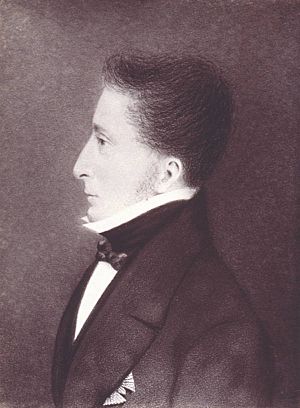Sir John Eardley-Wilmot, 1st Baronet facts for kids
Quick facts for kids
Sir John Eardley-Wilmot, Bt
|
|
|---|---|
 |
|
| 6th Lieutenant Governor of Van Diemen's Land | |
| In office 21 August 1843 – 13 October 1846 |
|
| Preceded by | John Franklin |
| Succeeded by | William Denison |
| Personal details | |
| Born | 21 February 1783 London, England, United Kingdom |
| Died | 3 February 1847 (aged 63) Hobart, Van Diemen's Land |
| Spouse | Elizabeth Emma Parry & Elizabeth Chester |
Sir John Eardley Eardley-Wilmot, 1st Baronet (born 21 February 1783 – died 3 February 1847) was an important politician in the United Kingdom. He served as a Member of Parliament (MP) for North Warwickshire. Later, he became the Lieutenant-Governor of Van Diemen's Land, which is now known as Tasmania.
Contents
Early Life and Career
John Eardley-Wilmot was born into a family with a strong legal background. His father and grandfather were both well-known legal figures. He went to Harrow School, a famous school in England. After his studies, he became a barrister in 1806, which means he could argue cases in court.
In 1821, he was given the special title of a baronet. This is a hereditary title, like a knight, but it can be passed down in the family. He also wrote books about law and crime. One book discussed how to reduce crime.
A Voice in Parliament
Eardley-Wilmot was elected to the House of Commons in 1832. This is where laws are made in the UK. He represented the area of North Warwickshire until 1843.
He was very interested in social issues. In 1840, he attended an important international meeting. This meeting was about ending slavery around the world. A large painting at the National Portrait Gallery shows him at this event. He is seen with Dr. Stephen Lushington, a judge, standing behind the main speaker.

Governor of Van Diemen's Land
In 1843, Eardley-Wilmot was chosen to be the Lieutenant-Governor of Van Diemen's Land. He arrived in Hobart on August 17th. He was likely chosen because he had shown a keen interest in how to deal with crime. He believed that young prisoners, under 21, should be kept separate. He also thought special efforts should be made to help them change their ways. This idea was quite advanced for his time.
Challenges as Governor
Soon after he arrived, Eardley-Wilmot faced some difficulties. He disagreed with a judge by stopping the execution of a prisoner. He felt that the death penalty should only be used for crimes clearly proven in court. In this case, only robbery had been proven.
He traveled around the island and seemed to be a popular leader at first. However, many prisoners were arriving in Van Diemen's Land. This meant that expenses were increasing. The governor also had to follow strict rules from the government in Britain.
In 1844, Eardley-Wilmot suggested a change to land prices. The British government agreed to his idea in 1845. He also tried to raise taxes on goods like sugar and tea. But the people living there strongly opposed these new taxes, so they were removed.
The British government did not understand that using convict labor was expensive. Eardley-Wilmot was blamed for problems with a system he could not change. He tried to save money by lowering the salaries of government officials. But some officials, like the chief justice, argued against this.
Six members of the local council disagreed with his budget plans. They left the council, which meant there were not enough people to make decisions. This caused a lot of public anger against the governor.
Recall and Legacy
In April 1846, Eardley-Wilmot was called back to Britain. The official reasons for his recall were not very clear. They suggested he had not shown enough "active care" for the moral well-being of the convict system.
Privately, the new colonial secretary, Gladstone, told Wilmot that he was not recalled for his official work. Instead, there were rumors about his personal life. Wilmot strongly denied these rumors and asked for the names of his accusers. However, he did not receive a reply.
He died on February 3, 1847, worn out by worry. Gladstone later tried to make amends by writing to one of Wilmot's sons.
Wilmot was married twice. He had children from both marriages. One of his sons, also named John, became the next Baronet. There is a monument in Hobart that honors Wilmot. It was built with money collected from the public.
Wilmot is also a character in the historical novel "Part an Irishman: The Regiment" by T.S. Flynn.
Memorials
The town of Wilmot in Tasmania was named in his honor.

